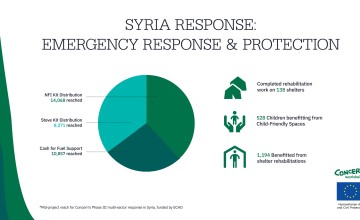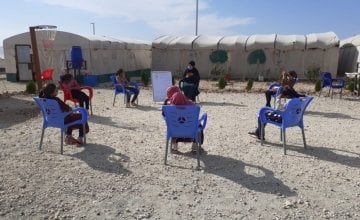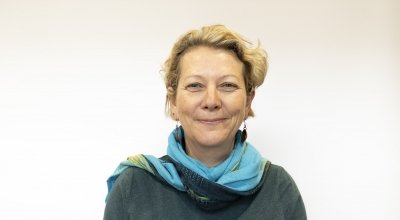
Knowledge Hub
Numbers may never tell the full story of a humanitarian crisis, or of the emergency responses to those crises. But if you’ve ever wanted to delve into what we do with a grant once it’s received, and how we measure success, here’s a look at how we’re using a grant from the European Civil Protection and Humanitarian Aid Operations (ECHO) to fund our response in Syria.
Last year, in 2020, Syria entered the ninth year of a protracted civil war. This March, it will enter its tenth. In addition to other effects, the Syria crisis has brought with it a large humanitarian impact, displacing over 12 million people and leaving nearly as many in need of humanitarian assistance. Many of you reading this may have already supported Concern’s work in Syria (and the Syrians displaced in Turkey and Lebanon).
But where does that money go? With funding from the European Civil Protection and Humanitarian Aid Operations (ECHO), Concern has now completed the third phase of a multi-sector response to the humanitarian crisis in the region. If you’ve ever been curious as to how a grant is spent, this will give you a behind-the-scenes look. It may not always make for dramatic photography, but it’s the essential, basic work that saves lives every day.
The state of humanitarian needs in Syria

The United Nations Office for the Coordination of Humanitarian Affairs reported over 70% of Syrians still living in Syria as being in need of some form of humanitarian assistance. This does not include the millions of Syrians living outside of the country, many as refugees in informal settlements who require similar levels of assistance.
This includes 5.9 million Syrian women, 5.8 million Syrian men, and 5 million Syrian children. What was once a country with a thriving middle class now sees 83% of its citizens living below the international poverty line of $1.90 per day. 33% don’t have enough food to meet their daily nutrition requirements. The conflict has also impacted local and national infrastructure, including water, sanitation, and hygiene (WASH) — all of which are especially necessary now given the Covid-19 pandemic.
Concern’s Syrian response: the challenges, and the results

In quarter three of 2020, Concern completed the third phase of a multi sector response in Syria, funded by ECHO to address many of the needs outlined above. Emergency response is never easy, but a few additional challenges over the last year have continued to affect humanitarian response for all organizations currently in the country. As of now, our three biggest challenges are:
- Increased conflict leading to additional displacement and instability
- Declining value of the Syrian Pound, which has inflated food prices and increased levels of food insecurity
- Covid-19 has closed borders, limiting the work we can do. Fortunately, we have been able to focus on one of the key areas of prevention in this pandemic, WASH.
A protracted, complex emergency like Syria means that our humanitarian response plans continue to evolve as situations change and priorities shift. The latest phase of our response inside Syria has focused on:
- Improving water, sanitation, and hygiene services;
- Making sure the most vulnerable families have enough safe and nutritious food;
- Providing psycho-social support and protection of those we support, for example by setting up child-friendly spaces.
Why WASH works

Repairing just one water station or network has some of the greatest benefits in a situation like Syria. By providing emergency assistance with water points and latrines in displacement camps (reaching 8,824), trucking clean water into four camps (reaching 17,041), and rehabilitating eight water stations (reaching 220,845), this has supported 605,570 people to have access to sufficient and safe water.
Investing for a different kind of growth

Beyond water, we’re also making sure that Syrians get the assistance they need to get their daily amount of calories and nutrients. With inflation driving up food costs and many families often on the move, this is a constant challenge.
Food vouchers and baskets are one way we work in Syria to meet what we call in the humanitarian sector an acceptable “food consumption score” (FCS). The basic gist of this technical term is that we want to make sure that not only are the people we work with eating enough, but that they’re also eating enough of the foods that will get them the vitamins and minerals they need to stay healthy (especially for children whose bodies are still developing). In less than a year, we’ve invested nearly $150,000 in food vouchers for Syrian families.
But in many areas, there is room to grow. We’ve allocated a portion of our ECHO funding to support over 500 families with vouchers for seeds and farming equipment to grow gardens on their land, adapting to the challenges of climate change and limited resources.
Measuring success
When we measure the success of this, however, we don’t look at the money spent: We go back to the food consumption score to better understand how these vouchers help families in the long run. In less than a year, we’ve reached an estimated 17,500 people, and nearly 82% are now reporting acceptable food consumption scores.
What does that mean, practically speaking? Healthier families, reduced levels of hunger, and removing a small but hard-hitting psychological weight for many parents.
Emergency response and protection

Smaller numbers, greatest impact
Not every number is a big one, but their impact is just as great. With 13.2 million people in need of protection in Syria due to active conflict and new displacement creating complex crises, much of this particular ECHO grant has also responded to vulnerable families living in informal camps and settlements.
Some of our proudest numbers, are 1,194 people reached with shelter rehabilitations (a total of 138 shelters), and 572 children enjoying our Child-Friendly Spaces. In terms of our work, we can see how a water delivery or the repair of a water point in a relatively short amount of time has a big impact with a relatively small investment of time and resources. They go a lot further to protecting the safety and dignity of Syrian civilians, and they help children’s futures which is immeasurable.
Ahmed’s story

11-year-old Ahmed was playing when he stumbled upon an object that looked like a pen. The object, an Explosive Remnant of War (ERW), exploded in his hand. Since Ahmed was a regular attendee of Concern’s Child-Friendly Space (CFS) in the camp where he lives, the family were able to contact Concern who provided emergency cash so that Ahmed could have urgent surgery and save his hand.
Ahmed lives with his family in an informal settlement (pictured above) in Syria, which is home to over 1,000 internally displaced persons (IDPs). He lives with his mother, father and five siblings aged between one and 17 years old. The family fled their home due to conflict. The settlement where they now live is adjacent to a huge rubbish tip, in which mines and other explosive legacies of war occasionally surface, putting families living in the area at serious risk.
Has surgery thanks to ECHO funding
Concern has been operating a Child-Friendly Space in the camp where Ahmed lives since March 2019, providing protection activities for children and caregivers. These activities range from psycho-social support through play, social and emotional learning, and life skills. Concern currently operates 14 Child-Friendly and Girl Safe Spaces across northeast Syria in camps, informal settlements and urban locations.
Ahmed and his two brothers attended these spaces between 2019 and 2020. When the accident happened last October, Ahmed’s mother, Reem, approached Concern for support. We were able to support so Ahmed could have critical surgery on his hand immediately after the accident.
Unfortunately, Ahmed lost three fingers because of the accident. However, the vital surgery ensured that the wound was not infected and that the rest of his hand could be saved. Ahmed now attends physiotherapy at the local hospital on a weekly basis to develop mobility on his affected hand.
Ahmed’s mother Reem spoke about the accident:
We are glad that Concern were able to support Ahmed to get his surgery. He is still traumatised now though and all the children are scared of going near the rubbish. Ahmed loved attending the CFS centre and would like to attend more.
Our support doesn’t end there

Following the accident, the team on the ground, in partnership with another organisation, delivered training so that children can identify and protect themselves from mines and other explosives. According to a report by UNICEF, over 4.3 million children across Syria are at risk from explosive hazards left behind after years of conflict. Ahmed’s case highlights the risks children in Syria face.
Other ways to help
Donate now
Give a one-off, or a monthly, donation today.
Join an event
From mountain trekking to marathon running, join us for one of our many exciting outdoor events!
Buy a gift
With an extensive range of alternative gifts, we have something to suit everybody.
Leave a gift in your will
Leave the world a better place with a life-changing legacy.
Become a corporate supporter
We partner with a range of organisations that share our passion and the results have been fantastic.
Create your own fundraising event
Raise money for Concern by organising your own charity fundraising event.





